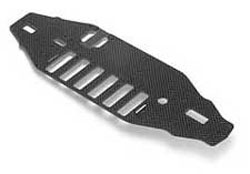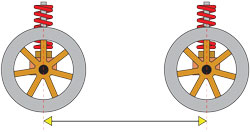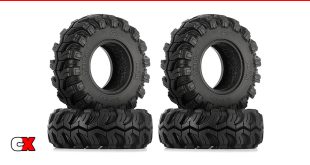
What is the Chassis?
The Chassis is the main component of any vehicle. This is the backbone, or base, that the rest of the parts will be bolted to (in some fashion).
There are really only 4 types of chassis compounds: Molded Composite (or Plastic), Carbon Composite, Fiberglass and Woven Carbon Fiber (also known as Graphite).
Molded Composite: Molded Composite chassis’ are normally a tub design chassis and found in most RTR or lower level cars. They have ribs and ridges in them for re-enforcement, making them the heaviest of the bunch, but also providing a good bit of flex for traction.
Carbon Composite: Carbon Composite is basically an upgraded Molded Composite tub design. It’s lighter, stronger and more rigid than the standard Composite chassis, making it a great upgrade for racing. It is also formed with ribs and ridges for re-enforcement. Due to its composition, this chassis usually makes your car more responsive.
Fiberglass: While not a real popular choice anymore, Fiberglass chassis’ were used a lot with pan cars. It’s inexpensive, easy to produce and has good flex and strength properties.
Woven Carbon Fiber: Popular for it’s beautiful look, the Carbon Fiber, or Graphite, chassis is typically comprised of an upper and lower deck that spans the length of the car. This chassis is included in just about every high-end racing car, from Touring Cars to 4WD offroad buggies. They are strong, lightweight and usually have aluminum standoffs that can be added or removed to change the flex characteristics.
Aluminum: Almost all 1/8 scale (and now some 1/10 scale) offroad cars include an aluminum chassis. These have similar rigidity qualities to the Woven Carbon Fiber, but they offer a much higher strength and durability factor. Cars with an aluminum chassis don’t have an upgrade – this IS the upgrade.
Some cars have multiple options, but the upgraded chassis (molded to carbon, fiberglass to carbon fiber) are always going to be a better performing chassis.
Tuning with the Chassis
Molded Composite
• Usually available as a single piece
• Inexpensive to replace
• Lots of flex, meaning more rear grip
Carbon Composite
• Usually available as a single piece
• Somewhat inexpensive to replace
• Minimal flex
Fiberglass
• Requires a top deck (for anything other than a pan car)
• Inexpensive to replace
• Adding or removing posts can change the flex characteristics
Woven Carbon Fiber
• Requires a top deck (for anything other than a pan car)
• Can be expensive to replace
• Adding or removing posts can change the flex characteristics
• Strong base platform
Aluminum
• Extremely high strength
• Expensive to replace
• Flexible design
• Strong base platform
• Can be cut (and bent) to not require a top deck
Back to the RC Suspension Tuning Guide.
 CompetitionX CompetitionX is the most up-to-date source for RC Car News, Reviews and Videos for Radio Control. We also have the most comprehensive Manual Database on the web.
CompetitionX CompetitionX is the most up-to-date source for RC Car News, Reviews and Videos for Radio Control. We also have the most comprehensive Manual Database on the web. 

One comment
Pingback: RC Suspension Tuning Guide – Battery Placement - RC Cars News